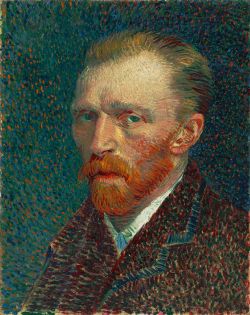Vincent van Gogh
- "Van Gogh" redirects here.
- For a timeline, see Vincent van Gogh chronology
| Vincent Willem van Gogh | |
 Self-portrait (1887).
| |
| Born | March 30, 1853 Zundert, Netherlands |
|---|---|
| Died | July 29, 1890 Auvers-sur-Oise, France |
| Occupation | Painter |
Vincent Willem van Gogh (IPA:/vɑn xɔx/) listen ▶ (March 30, 1853–July 29, 1890) was a Dutch painter, classified as a Post-Impressionist. His world-famous, immediately recognizable paintings show the objects, people and places in his life with bold, usually distorted, draughtsmanship and visible dotted or dashed brushmarks, which are intensely yet subtly coloured.
He is popularly known as much for his embodiment of the stereotype of the tortured romantic artist as he is for his work, which is seen as the visual expression of his life. Although his life is well-documented, there are several common false beliefs about him, including the myth that he cut off his ear (it was only the lobe), that he killed himself because no one recognized his talent (in the last six months of his life he received generous accolades which he found very disturbing), and that he painted as he did because he was mad (he painted during his lucid periods).
He produced all of his work—some 900 paintings and 1100 drawings—during the ten year period before he committed suicide. Most of his best-known work was produced in the final two years of his life. In the two months before his death he painted 90 pictures.
He was afflicted with increasingly recurrent periods of mental ill health, spending time in a psychiatric hospital. His state of mind was not helped by overwork (especially as he did much of it outside in the hot sun), bad dietary habits, and dependence on tobacco, coffee, and alcohol. There are many competing theories regarding his medical condition including bipolar disorder and temporal lobe epilepsy, possibly exacerbated by poisoning from excessive drinking of absinthe. His career was cut short too early for him to reap success during his lifetime; his fame then grew slowly, helped by the devoted promotion of it by his widowed sister-in-law. A major show of 71 paintings was held in Paris eleven years after his death.
Grouped by critics with the Post-Impressionists, a pioneer of what came to be known as Expressionism, Van Gogh has had an enormous influence on 20th century art, especially in the early part of the century, when many paintings of the Fauves and German Expressionists, particularly Die Brücke are highly derivative. His energetic approach to the painted surface follows a lineage to the Abstract Expressionism of Willem de Kooning and beyond.
His brother Theo, an art dealer with the firm of Goupil & Cie, was a central part of Vincent's life, continually providing financial support. Their lifelong friendship is documented in the large collection of letters they exchanged from August 1872 onwards. These letters provide much insight into the life of the painter, and show him to be a talented writer with a keen mind. Theo is reported to have remarked that one day his brother would be to art what Beethoven was to music.[1]
In Dutch, the name Gogh is pronounced [xɔx] or [ɣɔx], the latter especially in North Brabant, where h
- ↑ Theo's comparison of Vincent and Beethoven was recounted by his son, another Vincent Willem van Gogh, in conversation with Ken Wilkie, see Wilkie, K. In Search of Van Gogh, 1991 (first published as The Van Gogh Assignment, 1978) page 16